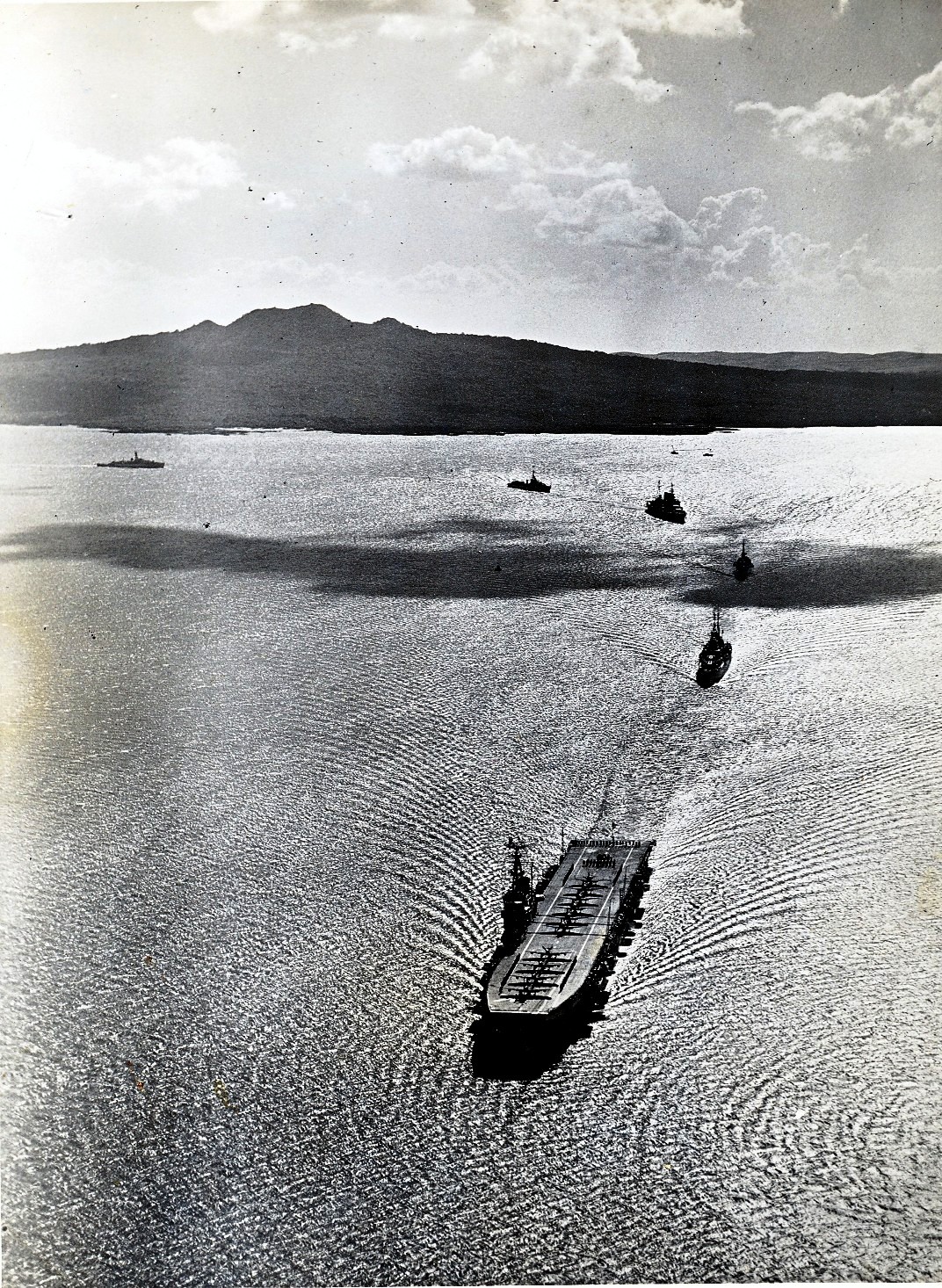Mar. 15, 1950; HMAS SYDNEY [III] leads 11 RAN and RNZN ships into Waitemata Harbour, Auckland - Whites Aviation, ATL.
6870. Seven of the 11 ships involved in the Mar. 1950 Fleet Entry at Auckland are seen here itself, with HMAS SYDNEY with the Modified Dido Class cruiser HMNZS BELLONA astern, with heavy cruiser HMAS AUSTRALIA [II] fourth in line amidst two RAN destroyers, WARRAMUNGA [I] AND BATAAAN, and two RNZN frigates following, with the remaining vessels out of the image.
THE GORDON C. EVANS HMAS SYDNEY 1948-1952 ALBUM: Mar. 15, 1950. SYDNEY leads 11 ships into Auckland - Whites Aviation.
1774. Front Page News. The arrival of 11 warships led by HMAS SYDNEY [III] was splashed over six columns by the Auckland Star on March 15, 1950. The heading read 'Impressive Naval Force Arrives in Port. City Welcomes N.Z. and Australian ships. '
The line-up with photo above was identified as HMAS SYDNEY [III],light cruiser HMNZS BELLONA, destroyer HMAS WARRAMUNGA [I], heavy cruiser HMAS AUSTRALIA [II] , destroyer HMAS BATAAN, and frigate HMNZS TAUPO. Out of picture were the RNZN ships PUKAKI, TUTIRA, and HMNZS ROTITI. The submarine HMS TELEMACHUS - on loan to the RAN - joined 20 minutes later, escorted by the frigate HMAS MURCHISON.
Eleven ships in all, plus the New Zealand cruiser HMNZS BLACK PRINCE already docked at Devonport.
The fleet was under the command of Rear Admiral J.A.C. Eccles, with Captain R.R. Dowling, RAN, in command of SYDNEY and Captain G.C. Oldham, RAN in charge of HMAS AUSTRALIA [II].
The paper noted that HMS TELEMACHUS was only the second British submarine ever to visit Auckland.
Two Sea Fury fighter bombers from SYDNEY had made a low pass over the city early in the morning, before the fleet's appearance.
Photo: Whites Aviation, Auckland, copyright expired. The photo is from the collection of CPO Gordon Curtis Evans, Air Artificer, RN [ret.], and kindly made available to the Unofficial RAN Centenary 1911-2011 Photostream. Submitted by Mr Evans, the photo has also appeared in the online magazine of the Benbow 2s, a service organisation of the Royal Navy's 1941 Apprentice Artificer entry year group. A cropped version of the photo has more recently appeared in the Topmill Pty Ltd book 'Aircraft Carriers and Squadrons of the Royal Australian Navy' edited by Jonathan Nally [Topmill Sydney, ca2010] p33. It also appears in the RAN Archives, Navy Heritage Collection.
THE GORDON C. EVANS HMAS SYDNEY 1948-1952 ALBUM: Mar. 15, 1950, passing Rangitoto volcano into Auckland - Whites Aviation.
1775.SYDNEY here leads HMNZS BELLONA and other units into Auckland, passing the volcano Mt Rangitoto in the distance. While the traditional Trans-Tasman rivalry had been known appear in interaction between these two Navies, overall they are the best of friends. Think about what happened on Feb. 26, 1951, when a Sea Fury from HMAS SYDNEY [III] mistakenly fired four practice rockets at the cruiser HMNZS BELLONA [second ship in this photo ] during Commonwealth naval exercises off Storm Bay Tasmania.
The story is told in Colin Jones's book 'Wings and the Navy 1947-1953' [Kangaroo Press, Sydney 1997] at page 56, and further detail is given in Sea Power Centre Australia's online history of 805 Squadron.
One of the rockets hit the cruiser's quarterdeck, damaging a boat being prepared for the fleet regatta in Hobart when the exercises were over.
The Kiwi's suspected SYDNEY's Sea Fury of deliberately shooting up their regatta boat, Colin Jones says ... until the pilot [805 Squadron's Lt Peter Seed] was found to be a New Zealander.
There are some confused, and exaggerated reports on this incident [suggesting BELLONA was hit by four rockets] but Seapower Centre Australia's online history of 805 Squadron gives some further details, and the story of an intriguing technical sequel.
The Sea Fury pilot Lt Seed [later Lt-Commander} was adamant that he had not triggered his rockets, but that they had fired spontaneuosly. When no fault was found in his aircraft's firing mechanism it was generally supposed to have been an inadvertent human error by the pilot. During SYDNEY's first tour in Korea later that year, however, it was discovered that the Sea Furies' armament circuits were susceptible to radiation from Sydney's powerful radio transmitters at certain frequencies, and that this may have caused the accident off Storm Bay. Fortunately there had been no serious injuries.
In SYDNEY's 20th Carrier Air group of 35 Fliers in 1949-50, just seven pilots and observers were Australians, including two from the RAAF*; four were New Zealanders; and 19 were Royal Navy fliers on loan. Source; Colin Jones, 'Wings and the Navy 1947-1953' {Kangaroo Press, Sydney 1997] p41.
* One of the two former RAAF men, WWII veteran Lt Keith Clarkson, would be SYDNEY's first casualty during the Korean War, shot down by ground fire while attacking a road convoy on Nov 5, 1951.
Photo: Whites Aviation, Auckland, copyright expired. The photo is from the collection of CPO Gordon Curtis Evans, Air Artificer, RN [ret.], and made available to the Unofficial RAN Centenary 1911-2011 Photostream.



No comments:
Post a Comment